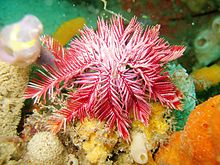Articulata (Crinoidea)
| Articulata | |
|---|---|
 |
|
| A Passion Flower feather star (Ptilometra australis) |
|
| Scientific classification | |
| Kingdom: | Animalia |
| Phylum: | Echinodermata |
| Class: | Crinoidea |
| Subclass: | Articulata |
| Orders | |
|
Bourgueticrinida |
|
Bourgueticrinida
Comatulida
Cyrtocrinida
Isocrinida
Millericrinida
Articulata are the only extant subclass of the class Crinoidea. The group includes "sea lilies" and "feather stars". The Articulata are differentiated from the extinct subclasses by their lack of an anal plate in the adult stage and the presence of an entoneural system. Articulata are stalked echinoderms with pentamerous symmetry. The stalk, which consists of numerous disks held together by ligaments, supports a calyx or cup made of circlets of calcerous plates. In Comatulids, the stalk develops following the larval stage, but the juveniles shed all but the topmost disk to take up a free-living existence. Five often branched arms, which consist of articulated series of ossicles, extend from the oral plate and form the food-capture mechanism of Articulata. The arms of Articulata are pinnulate in that they have alternating pinnules branching out along them to effectively increase the surface area for feeding. These pinnules all have ciliated ambulacral grooves that converge to form larger grooves in the arms that lead down to the mouth located beside the anus on the upper surface of the oral plate. Articulata are passive suspension feeders. They capture algae with triplets of tube feet located on the pinnules, and the ciliated ambulacral canals transport this algae to the mouth. Although they are passive feeders, some Articulata have been observed to move to better feeding areas either with locomotory mechanisms at the base of the stalk or by detaching and pulling themselves with their arms. Currently there are 540 described species of Articulata that fall into two major orders. The bourgueticrinids which have the traditional stalked body form account for about 15% percent of the known species while the comatulids are unstalked and account for most of the rest.
The Articulata are subdivided into the following orders and families:
Articulata first appeared in the fossil record during the Triassic period although other, now extinct crinoid groups, originated in the Ordovician.
...
Wikipedia
